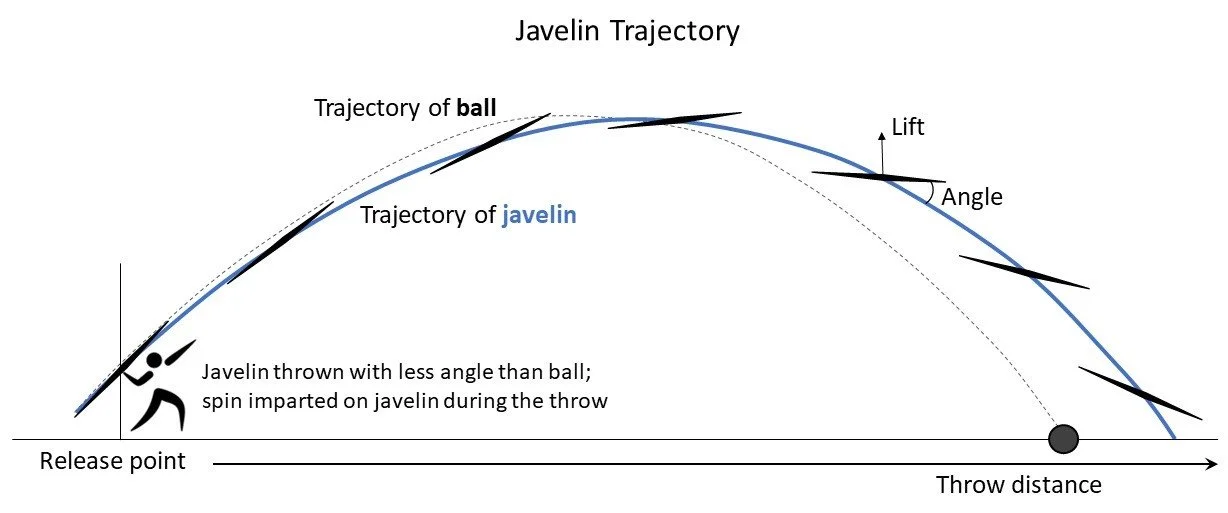More than Muscle - Hidden physics of the javelin
The best javelin throwers in the world will soon strut their stuff at the Olympics in Paris.
Elastic muscle power used to throw the javelin.
Did you know that humans are the only animals on Earth who can throw heavy objects really far and accurately? That makes the winner of this event truly special…they will be the greatest thrower of any animal on Earth (we can’t say that about the fastest swimmers or runners, or those who jump the highest or farthest)!
Human versus chimpanzee throwing. Humans are uniquely built to throw!
From: Nature Video. Click to play.
To learn more about our incredible ability to throw, watch this Nature video.
But winning isn't just about being strong. The champions need to understand wind, aerodynamics, and how energy moves around in our body. Let's dive into the science behind this awesome sport!
The Run-up: Building Energy
The throw actually starts way before the javelin leaves the athlete's hand. It begins with the run-up, where the thrower builds up kinetic energy - that's the energy of movement.
They need to find just the right speed - fast enough to create lots of energy, but not so fast that they can't do the throw in just the right way at the end.
As they approach the throw, the athletes transform their bodies into coiled springs. Turning sideways and performing crossover steps, they set themselves up for a rapid rotation that injects additional energy into the throw.
But the arm muscles used for throwing aren't actually very big. So, most of the javelin's flying energy comes from the run-up and that spin rather than the arm muscles we use to throw!
Run-up, throw, and flight of the javelin. From: https://www.youtube.com/watch?v=3db43A6Qnsw
The Throw: Energy Transfer in Action
During the throw itself, the thrower slams their front foot into the ground to stop suddenly, while spinning towards where they want to throw. This is where we see a big rule of physics at work - the conservation of energy.
All that energy from running doesn't just disappear when they stop. Instead, it moves into the only part still free to move - the throwing arm!
The shoulder works like a catapult. The muscles and tendons stretch out, storing elastic energy, then snap back to launch the javelin forward. This whip-like action creates huge power - about ten times more than what our leg muscles can do in a big jump or bike sprint!
Flying Through the Air: Aerodynamics at Work
Once the javelin is in the air, it's all about aerodynamics - the science of how things move through air.
Unlike throwing a ball, the best angle for a javelin isn't 45 degrees. Because the javelin can create lift like an airplane wing, throwers aim for a flatter angle, usually between 32 and 38 degrees. The exact angle depends on how fast they throw and what the wind's doing.
The way the javelin is pointing when it's released is super important too. Throwers try to line up the javelin's long axis with its flight path, often called throwing "through the tip". This cuts down on air resistance and helps it fly better.
Because our body rotates when we throw, the javelin gets some spin when we throw it. So it spins as it flies, which helps keep it stable - just like how a bullet or a footy spins to fly straighter. For right-handed throwers, this spin makes the javelin turn a bit to the left, so they have to aim a little sideways to compensate.
The javelin's nose also tends to dip down a bit in flight, so most throwers actually release it with the tip pointing about 5 degrees up.
Trajectory of the javelin. The angle of the javelin relative to the air creates lift like an airplane wing. Getting the javelin angles right - taking into account the wind speed and direction - is key to getting the javelin to fly well. Here, the flight of the javelin is compared to the flight of a ball, which can’t fly at all.
Battling the Wind
The wind plays a big part in javelin throwing too. If the wind's blowing towards the thrower (a headwind), they need to throw flatter to stop the javelin from diving down. If the wind's at their back (a tailwind), they can throw at a slightly steeper angle. Side winds are really tricky and make the throwers adjust even as they're running down the runway!
What to look for
These athletes aren't just strong - they're like practical physicists! They make split-second decisions about angles, wind, and energy that would be hard even for a computer to figure out.
As you watch the competition, look for throwers who seem to make their javelins float through the air. Watch how they run up, how explosively they release, and the beautiful arcs the javelins make as they fly.
You're not just seeing sport - you're watching the amazing mix of human skill and the basic laws of nature.
May the greatest thrower of any animal on the planet, win.
*Please feel free to republish this article online or in print for free provided the source is credited and no alterations are made. It is published under a Creative Commons — Attribution/No Derivatives license.


